Will Sliding Oil Prices And The Global Economic Outlook Be Taken Into Consideration?
When the Organization of Petroleum Exporting Countries (OPEC) meets on December 6, it will have to confront weakening demand prospects along with a bullish outlook for global oil supply, but it is not forgone conclusion the gathering will conclude with an agreement by members to reduce production.

Global oil prices have been on a sharp downward trajectory for the past two months, a situation that would normally cause OPEC to cut output in response – especially with growing expectations of a global economic slowdown. However, it remains to be seen if other considerations – such as maintaining good relations with the United States – will influence the outcome this time around.
Oil prices were on an upward swing for most of the summer, as the United States’ decision to re-impose sanctions on Iran (including its energy sector) – combined with Venezuela’s escalating economic crisis – sparked fears of a significant supply crunch in the oil markets.
Prices for global benchmark Brent crude oil rose as high as $86 per barrel by early October, while US benchmark West Texas Intermediate (WTI) hit $76 per barrel during the same period. OPEC at the time concluded there was “an overall healthy balance between supply and demand.” This did not go down well with US President Donald Trump, who publicly and repeatedly accused the group of “ripping off the rest of the world.”
In response to these attacks and broader concerns about the risk to the global economy, oil heavyweight Saudi Arabia ramped up production, while temporary waivers subsequently granted by the Trump administration to major buyers of Iran’s oil – to head off an oil price shock – also helped ease market worries.
Oil prices have plunged since peaking in early October, with Brent sliding down to around $60 per barrel and WTI close to $50, with Trump seizing the opportunity on multiple occasions to take the credit for the decline. He even listed keeping a lid on energy costs as one reason for not imposing harsher sanctions on Saudi Arabia over the murder of Washington Post columnist Jamal Khashoggi.
Saudi Arabia has a lot of clout within OPEC and tends to dominate the group’s agenda. Its significant spare capacity means any attempts to cut overall production would be an exercise in futility unless the kingdom is on board. Weak oil market fundamentals (more on that below) and the less severe-than-expected disruption to Iran supply should translate into a cut in production, but will Saudi Arabia want to antagonize the White House in this current environment?
The tone of recent OPEC’s commentary underscores the clear concern within the group about the direction of the oil market. Following a meeting earlier this month, the Joint OPEC-non-OPEC Ministerial Monitoring Committee (which includes Russia, the world’s number one oil producer) warned in a statement that, “2019 prospects point to higher supply growth than global requirements, taking into account current uncertainties.”
They went on to note “the dampening of global economic growth prospects” could have a negative effect on global oil demand next year – further widening the gap between supply and demand.
US crude oil production, powered by the shale oil sector, has continued to increase at a faster rate than many expected, averaging over 11 million barrels per day in August and October. The Energy Information Administration (EIA) projects US output will average 10.9 million barrels per day for all of 2018, up from 9.4 million barrels last year, and will average 12.1 million barrels per day in 2019.
In addition to more supply from Saudi Arabia and the US in recent months, Russia has also been pumping out oil at record levels. On the other side of the equation, the ongoing trade war between China and the US has fueled business uncertainty around the world and caused global economic activity to stagnate – exacerbating the growing supply-demand gap that has OPEC on edge. 
Source: International Energy Agency
Faced with surging non-OPEC production plus plateauing global growth, you can expect OPEC’s more hawkish members – such as Iran and Venezuela – to demand a joint output cut in an effort to prop up oil prices. It remains to be seen if the more dovish countries, led by Saudi Arabia, will sign on and prevent oil prices from falling even further.
The upcoming gathering of G20 leaders in Argentina could include talks on production to find a balance between the needs of oil-producing nations and their customers. As the International Energy Agency, an international agency representing OECD countries, said in its latest Oil Market Report: “We should also recognize the interests of the producers. For many countries, even though their output might have increased, prices falling too far are unwelcome.”








